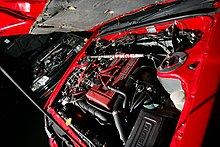Nissan FJ engine
They were one of the first mass-produced Japanese engines with more than two valves per cylinder, as well as having electronic fuel injection.
The FJ series came in 2.4 L guise as a rally motor for the 240RS and 2.0 L for general production models.
[citation needed] The FJ series has an aluminium head, chain driven cams, and an iron block.
It featured large ports, dual valve-springs and a wide angle bucket on shim valve-train design similar to other (later) Nissan twin-cams such as the VG, CA, RB, and KA series DOHC motors as well as the previous S20 straight-6 DOHC motor from the early 1970s GT-R.
Later intercooled versions produced 205 PS (151 kW) with a slight boost increase and smaller turbocharger exhaust housing.
The intake plenum chamber was shortened in the S12 compared with the DR30 because of the smaller engine bay and thus produced slightly less torque and power.
200 or more were produced as a homologation car engine of World Rally Championship at that time according to the Group B regulation.




